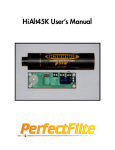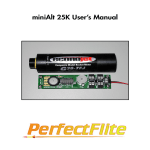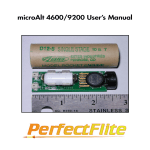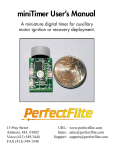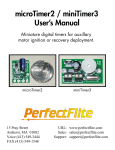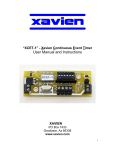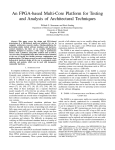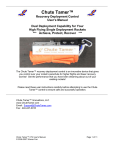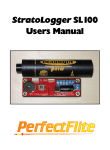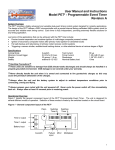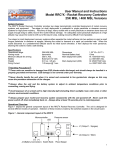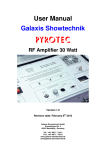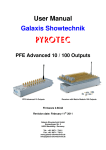Download miniAlt/WD manual
Transcript
miniAlt/WD User’s Manual miniAlt/WD User’s Manual A miniature data logging altimeter with two event deployment capabilities for high power rockets. 15 Pray Street Amherst, MA 01002 Voice (413) 549-3444 FAX (413) 549-1548 URL: www.perfectflite.com Sales: [email protected] Support: [email protected] Contents Preface ............................................................................... 1 Theory of Operation ............................................................ 2 Preliminary Setup Getting to know your altimeter .................................................. 3 Powering the altimeter ............................................................ 4 Connecting external switches .................................................... 5 Configuring the altimeter ......................................................... 7 Numerical reporting method ..................................................... 9 Installation Basic payload module ........................................................... 10 Sampling hole size chart ........................................................ 11 Apogee-only deployment ....................................................... 12 Dual-event deployment ......................................................... 13 Ejection Charges Ejection charge igniters ......................................................... 15 Making ejection charges ........................................................ 15 Operation Sequence of events .............................................................. 16 Computer connection ............................................................ 18 Preflight checklist ................................................................ 19 On-ground testing ............................................................... 20 Cautions ........................................................................... 20 Appendix .......................................................................... 21 Specifications .................................................................... 22 Mounting Hole Template .................................................... 24 Warranty .......................................................................... 25 Congratulations on your purchase of the new miniAlt/WD altimeter! Please read these instructions carefully before attempting to use the altimeter to insure safe and successful operation. Your new altimeter provides several useful functions: Peak altitude determination. After a flight with the altimeter installed, your rocket’s peak altitude (apogee) will be reported via a series of audible beeps. This will allow you to study the effect of various design parameters (fin/nose cone shape, fin airfoil, number of fins, etc.) on your rocket’s performance. It can also be used by clubs for altitude contests - compete to see who can get the most altitude out of a given engine size, etc. Electronic deployment of recovery devices. The altimeter provides electronic outputs for firing ejection charges at two points during flight: apogee and secondary (adjustable from 300 feet to 1700 feet above ground level.) Firing the first charge exactly at apogee insures that the recovery system is deployed while the rocket is traveling at the slowest possible speed. This minimizes the likelihood of rocket damage due to “zippered” body tubes and “stripped” parachutes which occur when deployment occurs at higher velocities. Electronic deployment is preferable to using the engine’s built-in timed ejection charge, which can vary from engine to engine and is usually limited to two or three specific time delays (which may not be optimal for your particular engine/ rocket combination). While it is often adequate to use single-event ejection at apogee, a twoevent deployment option is also provided. This involves ejecting a small parachute or streamer at apogee, allowing your rocket to fall at a fast but controlled rate to the secondary deployment level of 300 to 1700 feet AGL (switch selectable). At this point a larger main chute is deployed to bring your rocket slowly and safely down for a soft landing. This has the significant advantage of reducing the distance your rocket drifts on windy days, making safe recovery easier and more certain. Download of flight data to a personal computer. After recovery, you can connect your altimeter to an IBM compatible or Macintosh computer with the optional data transfer kit. This allows you to view a graph of altitude vs. time for the first 5.7 minutes of flight. The data are also saved as a standard text file which can be imported into spreadsheet programs for further analysis (velocity, acceleration, sink rate, etc). 1 Theory of Operation The miniAlt/WD altimeter determines altitude by sampling the surrounding air pressure during flight and comparing it with the air pressure at ground level. As the altitude increases, the air pressure decreases, and the onboard microprocessor converts the pressure difference to altitude. When the altimeter is turned on, it reads a bank of configuration switches and saves their values in memory. It then checks the barometric pressure sensor to make sure that the pressure reading is within normal limits. If an abnormal condition is detected, an error is reported. If pressure readings are normal, the values of the mach delay and main deployment level switch banks are reported via the built-in beeper. The peak altitude of the previous flight is then retrieved from nonvolatile EEPROM memory and reported. Next the ground level elevation is sampled every 50 milliseconds, and the ejection charges’ power and continuity status is checked and reported as the altimeter awaits launch. The continuity is rechecked and reported approximately once per second during this period. The microprocessor also looks for a sudden decrease in pressure signifying a rapid increase in altitude (launch detection). When the altitude exceeds a preset threshold (160 feet above the ground reading), launch is detected. The previous 16 altitude samples are saved to logging memory, and additional samples are added every 50 milliseconds for the duration of the flight. While awaiting launch the ground level will be updated if a slow change is detected to compensate for thermal and barometric drift. If a mach delay value was entered into the configuration switches, the altimeter waits for the prescribed time to elapse before beginning to check for apogee. This prevents a sudden increase in pressure due to the transition from subsonic to supersonic flight from being interpreted as a false descent (apogee) so that the apogee chute is not deployed prematurely. After any Mach Delay period has elapsed, pressure readings are taken every 50 milliseconds and converted to altitude above ground level. The altitude results are inspected to determine apogee (peak altitude). When the derived rate of ascent decreases to zero, apogee is detected and a power MOSFET is turned on to supply power to the apogee event ejection charge igniter. The peak altitude reading is also stored in nonvolatile memory for later retreival. Altitude readings continue to be taken during descent, and are compared with the main deployment threshold that was read from the switch bank on power-up. When the altitude has decreased to the main 2 deployment level, another power MOSFET is turned on to supply power to the main parachute ejection charge igniter. When the altitude is less than 300’ and the sink rate is less than 4 feet per second, data collection is terminated. At this point the peak altitude is reported continuously at ten second intervals via a sequence of beeps. Getting to Know Your Altimeter: Refer to figure 1 below to identify the following items: A) Battery terminals (note polarity +/-) B) Power switch terminals C) Main ejection charge terminals D) Drogue (Apogee) ejection charge terminals E) Serial data I/O connector F) Audio beeper G) Main deploy switch bank (switches 1-3) H) Mach delay switch bank (switches 4-6) Figure 1: Parts identification 3 Powering the Altimeter The altimeter’s electronics can be powered by any source of 6 volts to 10 volts that can provide at least 10 milliamps of current. Standard 9V batteries can be connected using the supplied battery clip. Make sure that both of the clip’s snaps are gripping the battery terminals firmly to prevent power interruption due to vibration. The larger battery terminal or clip terminal can be compressed inward if necessary to insure a snug fit. While the miniAlt/WD will fit easily inside a 24mm body tube, a standard 9V battery will not. For limited-space applications we recommend a battery consisting of 5 or 6 type SR-44/357 Silver Oxide cells in series. This configuration is small enough to fit in a type “N” battery holder, yet provides enough power to run the altimeter for over 8 hours. Using Alkaline cells will reduce the runtime significantly. Many other types of batteries (lithium coin and button cells, type A23 batteries, etc.) may appear to have enough capacity to run the altimeter for a reasonable time, but are frequently rated for a maximum discharge current of under 1 milliamp. If this is the case, when they are connected to the miniAlt/WD they will become depleted in a short time. Always check the runtime of a new battery configuration with a reliable voltmeter before committing to flight. Terminal Block Note To attach wires to the terminal blocks, loosen the retaining screw (facing upward from the board), insert the stripped wire end from the side, and retighten the screw. Make sure that you strip enough insulation from the wire (~3/16”) so the bare wire (not the insulation) is gripped by the contact. Do not allow an excess of bare wire outside the terminal, as it could shortcircuit to adjacent parts or wires. Always use solid wire (or tin any stranded wire ends with solder) – the loose strands in untinned stranded wire can “escape” during wire insertion and make contact with adjacent terminals. After inserting the wires and tightening the connections, tug the wires with a pair of longnose pliers to insure that they are gripped tightly. You do not want these connections to loosen in flight! 4 Connecting Switches Connect a suitable ON/OFF switch to the power switch terminals. One important consideration for the power switch is that it be “bounce-free” – you do not want the switch to turn off momentarily during vibration or acceleration, as the altimeter could reset and deployment would fail. The miniAlt/WD can tolerate a two second loss of power without affecting operation, but it is always wise to use the best quality switches possible. The power switch should be mounted with the switch movement perpendicular to the travel of the rocket. This will minimize the forces placed on the switch during acceleration/deceleration, which could inadvertently move the switch to the “off” position. If the switch is on the outside of the airframe or near any of the recovery device rigging, a cover should be fabricated for the switch to prevent it from being bumped to the “off” position due to impact with the rigging. One popular switch is the spring loaded “Push on/Push off” switch. If this type of switch is properly oriented in the electronics bay adjacent to the vent hole(s), a pointed object can be inserted into the vent hole to turn the switch on or off. Since no part of the switching mechanism is outside of the rocket, it has no impact on drag or aesthetics, and cannot be activated (or deactivated) inadvertently. Some switches of this type (e.g. PerfectFlite #POPO depicted below) have two “poles”, or independent switch circuits, activated by the same plunger. These are shown wired in parallel for additional redundancy. plunger out, switch off plunger in, switch on 5 Another simple and effective switch can be made using a lever/plunger switch (eg. Omron SS-10T), a small piece of brass tubing, and a length of brass rod with a sharpened end. The brass tubing is secured to the top of the switch housing with a small amount of epoxy (do not use CA, as the outgassing during curing will get into the switch and ruin its contacts) such that when the sharpened end of the brass rod is inserted into the tubing it depresses the plunger. The switch assembly is mounted inside the altimeter bay, with a hole for the brass rod leading to the outside. The Normally Closed terminals of the switch are used in this case, so when the rod is inserted and the plunger is depressed the switch turns off (“opens”). A “remove before flight” flag can be hung from the end of the brass rod to remind you to turn on the altimeter. One advantage to using a Normally Closed switch is that failure of the external mechanical assemblies (brass tube) during flight will NOT turn the altimeter off. rod out, switch on rod in, switch off 6 Configuring the Altimeter Two sets of switches are provided for setting mach delay time and main recovery device deployment altitude. The switches are only read on powerup, so their status cannot be altered by flight induced vibration or shock. Any intentional modification of the switch settings should be done with power off so that they are read properly the next time the altimeter is turned on. The mach delay setting is used to prevent premature deployment of the apogee recovery device as the rocket makes the transition between subsonic and supersonic flight. During this period the pressure surrounding the airframe will increase suddenly, which could be interpreted as a decrease in altitude, triggering the apogee deployment event. If you think that your rocket will go supersonic, a computer simulation should be run to determine the time at which flight returns to subsonic speeds. Add in a safety factor of 20%-30% and enter the resulting time on switches 4, 5, and 6 according to the table below. The time that you enter should always be less than the simulation’s reported time to apogee. Important: If your rocket is not expected to exceed Mach 1, the mach delay time should be set to zero (switches 4-6 OFF). This will allow apogee detection to occur at the proper time. The altitude at which you would like your main recovery device to be deployed is set using switches 1, 2, and 3. Set the altitude high enough to insure that the chute will deploy fully in time to slow the rocket’s final descent, but low enough to prevent excessive drift. In most cases a setting of 500 to 900 feet is appropriate. If you have any doubt as to the time it will take for your chute to deploy, choose a number towards the upper end of this range and gradually reduce it if deployment speed allows. For small fields, loosely packed chutes, and windy conditions you may want to drop back to 300 feet. When the altimeter is first turned on, the current mach delay and main deployment settings are reported via the beeper (see the next section for details). This allows you to confirm that the correct settings are entered even if the altimeter is hidden inside your rocket. These settings are followed by a number representing the peak altitude attained on the altimeter’s last flight. 7 SW1 SW2 SW3 Altitude off off off 300 feet AGL off off on 500 feet AGL off on off 700 feet AGL off on on 900 feet AGL on off off 1100 feet AGL on off on 1300 feet AGL on on off 1500 feet AGL on on on 1700 feet AGL Table 1 - Main deployment settings SW4 SW5 SW6 Delay off off off 0 seconds off off on 2 seconds off on off 4 seconds off on on 6 seconds on off off 8 seconds on off on 10 seconds on on off 12 seconds on on on 14 seconds Table 2 - Mach delay settings 8 Numerical Reporting Numbers are reported as a long beep (separator), followed by a pattern of shorter beeps. With the exception of the one or two digit Mach Delay setting, all numbers are reported using up to five digits – a series of beeps for the first digit (tens of thousands of feet), a short pause, another series of beeps for the next digit (thousands of feet), etc. Leading zeroes are suppressed: 1,582 feet would be represented with four digits, not five digits as in 01582. Ten beeps are used to indicate the number zero (if zero beeps were used, you would not be able to differentiate between 2200 feet and 22 feet!). As an example, 12,560’ would be reported as: long beep-pause-beep-pause-beep-beep-pause-beep-beep-beep-beep-beeppause-beep-beep-beep-beep-beep-beep-pause-beep-beep-beep-beep-beepbeep-beep-beep-beep-beep-long pause Digit Reported as: 0 beep-beep-beep-beep-beep-beep-beep-beep-beep-beep 1 beep 2 beep-beep 3 beep-beep-beep 4 beep-beep-beep-beep 5 beep-beep-beep-beep-beep 6 beep-beep-beep-beep-beep-beep 7 beep-beep-beep-beep-beep-beep-beep 8 beep-beep-beep-beep-beep-beep-beep-beep 9 beep-beep-beep-beep-beep-beep-beep-beep-beep Table 3 - numerical beep sequences 9 Installation Basic record-only mode Your altimeter needs to be installed in a separate payload compartment, sealed from the pressure and heat of the ejection charge gasses. It is not OK to tie it to the shock cord and pack it in with the chute! The high pressure and heat encountered during ejection would damage the delicate pressure sensor’s diaphragm. If you are not using the electronic ejection features and are just interested in peak altitude determination or data collection, the simplest mounting method involves adding a sealed payload compartment to your rocket. This is just a section of body tube behind the nosecone with a sealed tube coupler connecting it to the main body tube (see figure 5). Some rockets already have such a payload section, and one can be added easily if yours does not. Loose fit Glue Tight fit Wadding Sampling hole Altimeter Figure 5: Installation for reporting only You must drill a clean-edged hole in the payload section to allow outside air pressure to be sampled by the altimeter. This hole should be as far away from the nosecone and other body tube irregularities as possible (3X the body tube diameter or more) to minimize pressure disturbances being created by turbulent airflow over the body tube. Sand the area around the hole as necessary to eliminate flashing or raised edges. Exact sizing of the hole is not critical, refer to the table on the next page for suggestions. 10 Diameter Length Hole Size 1” 5” .031” (1/32”) 1.6” 6” .047” (3/64”) 2.1” 6” .078” (5/64”) 2.1” 12” .156” (5/32”) 3.0” 12” .219” (7/32”) 3.0” 18” .344” (11/32”) Other “D” Other “L” H=D*L*.006 Table 4 - Payload Section Size vs. Sampling Port Hole Size While not strictly necessary, the single sampling hole can be replaced by several smaller holes distributed around the airframe’s circumference. This will minimize the pressure variations due to wind currents perpendicular to the rocket’s direction of travel. If you are not using ejection charges, mounting and wiring is straightforward. Simply place the altimeter in the payload section - it does not matter which end of the altimeter faces “up”. Use pieces of foam rubber in front of and behind the altimeter to prevent it from shifting under acceleration and deceleration. A wrap of foam weather-strip around the center portion of the altimeter will provide a snug fit in 24mm/BT50 size body tubes, and a “sleeve” made out of standard foam pipe insulation can be used for larger size tubes. Make sure that your foam rubber pieces do not block the path from the air sampling hole to the altimeter’s pressure sensor element. A channel can be cut in pipe insulation for this purpose; make sure that the channel lines up with the sampling hole and the sensor’s air inlet. Your payload section should close securely so that the altimeter is not “ejected” upon motor burnout deceleration or chute deployment shock. 11 Setting up the altimeter for use as a recovery device with apogee-only or two-stage deployment is necessarily more complex. You may want to gain some experience with your altimeter in “reporting only” mode before using it for deployment. Then begin with a simple apogee-only deployment application, and move on up to two-stage deployment after you’ve gained experience with electronically-fired ejection charges. The following suggestions can be used as a “starting point”, and should be adapted to suit your specific application. To insure the highest degree of safety, all recovery systems should be ground-tested prior to launching. Using redundant backups (e.g. motor ejection charge in addition to electronic deployment) is always a good idea whenever possible. Installation with apogee deployment Installation with apogee-only electronic deployment is similar to the standard installation noted above. The altimeter is mounted in the sealed payload compartment, and a small hole is drilled through the rear bulkhead for the ejection charge cable (see figure 6). Route the ejection charge cable through the bulkhead with the altimeter connector end in the payload section, leaving sufficient wire aft of the bulkhead to allow connection of the ejection charge. Seal the point where the ejection charge cable passes through the bulkhead with silicone, epoxy, or hot melt glue to prevent ejection charge pressure from entering the payload compartment. Make sure that the altimeter, battery, and wires are mounted securely so they will not shift under the high G forces experienced during acceleration and burnout/deceleration. Leave some slack in the cables to prevent the plugs from pulling out of the terminal blocks if things do shift. Prior to launch you will attach the ejection charge’s leads to the loose ejection charge cable ends, twisting them tightly and taping them to prevent shorts. The ejection charge will then be loaded into the rocket’s airframe immediately in front of the motor, with flameproof wadding inserted after it to protect the chute. Pack the chute next, being careful to position the shroud lines and shock cord away from the ejection charge cable to minimize the likelihood of tangling. Then join the main airframe and payload sections, making sure that they are sufficiently loose to allow separation when the ejection charge fires. The altimeter should not be switched ON until your rocket is loaded onto the pad to prevent wind gusts, etc from prematurely firing the ejection charge. See the Preflight Checklist section for more details. 12 Seal cable here Ejection charge Loose fit Glue Tight fit Wadding Sampling hole Altimeter and eject battery Figure 6: Installation for apogee deployment Choose a motor with a delay that is a few seconds longer than you would normally use with the specific motor/rocket combination. The motor’s charge will then serve as a backup in the event of a primary ejection malfunction. Installation with dual event deployment Again, there are many possible variations of the following installation scheme. Careful attention to the design of your installation will make the difference between a successful installation and a failure. Ground test your setup before launching to insure proper separation and deployment of recovery devices. The basic premise is that you want two separable parachute compartments and a single sealed electronics bay. Perhaps the simplest method involves a basic setup similar to the apogee deployment system described above, with an additional sealed chute compartment behind the nosecone (see figure 7). A small parachute or streamer is ejected from the compartment aft of the payload/electronics section at apogee, and a larger chute is ejected from the compartment between the payload section and nosecone at a lower altitude (set by the Main Deployment switch bank). The ejection cable leading into the forward parachute compartment should be sealed in the same manner as the aft one to prevent ejection gas entry into the payload compartment. Two additional precautions should be made: First, the joint between the payload section and the forward parachute compartment should be either a very tight friction fit or preferably a positive-retention system like screws or retaining pins can be employed. This will prevent the shock of the main chute deployment from 13 separating this joint and ejecting the electronics. Second, the fit of the nosecone to the upper parachute compartment should be tight enough to prevent inadvertent separation at apogee, but loose enough to allow separation upon main chute ejection charge firing. Seal cable here Apogee/drogue ejection charge Loose fit Seal cable here Tight fit Main chute ejection charge Glue Glue Drogue chute Main chute Wadding Wadding Altimeter and eject battery Sampling hole Figure 7: Installation for dual event deployment A number of companies sell electronics bays intended for use with larger rocket kits or with your own scratchbuilt design. These bays usually consist of a section of coupler tube sized to fit in the intended airframe, with bulkheads to seal both ends. The front bulkhead is typically glued in place, and the rear bulkhead is made removable to allow access to the electronics. When this type of arrangement is used the third center section of airframe can be eliminated, as the electronics are completely contained within the coupler. If the coupler is held into the forward chute compartment with screws, it can be quickly removed and transferred to another rocket to allow one altimeter to be shared among many rockets. 14 Ejection charges The ejection charges used to deploy your recovery devices can be purchased commercially or made at home. Since ejection charges contain a quantity of explosive black powder, extreme care must be exercised while constructing and handling them. Keep your face and hands away from the end of any ejection charge that has been loaded with powder! Do not look into or reach inside rocket airframes with live ejection charges loaded, and remember that an accidentally- ejected nosecone can severely damage anything in its path. The miniAlt/WD altimeter requires low current electric matches for ejection charge ignition. DaveyFire N28B or Oxral ematches are suggested. A convenient, lower cost alternative for smaller rockets can be made using miniature Christmas tree bulbs. A kit for making this type of charge is available from PerfectFlite, and complete directions are available on our web site for the do-it-yourselfer. Flashbulbs are sometimes used, but are fragile, expensive, bulky, and prone to accidental triggering by weak electrical currents. For increased reliability, multiple igniters can be used with a single charge. The igniters are connected in parallel and attached to the altimeter’s terminal block. If one igniter fails, the other(s) will ignite the charge, preventing ejection failure. The miniAlt/WD provides enough current to fire up to ten parallel connected DaveyFire/Oxral ematches, although two is generally deemed sufficient. Basic ejection charges can be made in the following manner. Cut a section of cardboard tube (the tubing from shirt hangers works well) about 1” long, and use hot-melt glue to fill in a plug at one end. Work the glue in from the end that you want to plug, rotating the tube between your fingers until a solid seal is attained. Set the tube (glue end down) on a piece of paper until the glue cools. When cool, cut away the excess paper and inspect the plug for uniformity of thickness (3/16” to 1/4” is good) and lack of holes. Insert your ejection igniter in the open end of the tube, being careful to not damage the delicate ignition head. Bend the lead wires over the lip of the tube and use masking tape to secure them to the outside of the tube. Set the tube/igniter assembly down, open end up, to prepare for the addition of black powder. Making a stand out of a small block of wood with appropriately-sized holes drilled in it will hold your tubes more securely during the filling/sealing operation. 15 Add the appropriate amount of FFFFg black powder (multiply the volume of the parachute bay in cubic inches by .01 to get grams of black powder) and gently tap the side of the tube to distribute the black powder around the igniter head. Using a section of 1/8” wooden dowel, carefully press a small ball of flameproof wadding in on top of the black powder so that the powder is completely covered. Do not press too hard or you may damage the igniter element. Seal the end of the ejection charge with melted wax or a disc of tape. The purpose of the seal is simply to hold the powder in. You do NOT want to use something stronger like epoxy, which would make the tube rupture upon ignition, possibly damaging your rocket’s airframe. Using a wax or tape seal will keep the ejection charge tubing intact, so that it can be reloaded and reused. If you use molten wax, melt the wax using a flameless method (not a candle!) and keep it away from any open containers of black powder. Your ejection charge is now complete. Store loaded ejection charges in a safe manner, with the igniter wire ends shorted together until immediately prior to use. Since the actual amount of black powder necessary can vary based on a number of parameters (powder type, nosecone/coupler to tube friction, etc.) you should test your ejection charges on the ground before flight. Start with a little less powder, and increase the amount until the airframe separates reliably. Then add 50% as a safety factor to account for variations in friction due to humidity, etc. Operation To insure proper operation of your altimeter and any associated deployment systems, you must observe and adhere to the following sequence of events. If you launch before the altimeter is ready, ground level will not be sampled properly and deployment will not function properly. If you don’t have proper continuity through your ejection charge igniters, the recovery devices will not be deployed and serious rocket/property damage can occur. Sequence of events Prepare your rocket and install the engine before setting up the altimeter. Do not install the igniter into the engine until you are at the launch pad. If you are not using electronic deployment (just using the altitude reporting function) you can ignore the sections of the following text that deal with ejection charges. 16 If you are using electronic deployment, the apogee and main ejection charges and associated igniters should be loaded into your rocket and the wires connected to the altimeter’s ejection charge terminals. The power switch should be OFF (open circuit) and the battery should be connected. Make sure that the apogee and main ejection charge cables are not swapped, and that no wires are shorting together or to any conductive objects. Also insure that adequate wadding or other protection is used to prevent the hot ejection charge gasses from burning your parachute and shock cord. At this point you can have the RSO inspect your rocket (if applicable) and proceed to the launch pad. Install the igniter in the engine and place the rocket on the launcher. Turn the power switch ON and listen to the series of beeps from the altimeter. A one or two digit number, representing the Mach Delay switch settings, will be reported first. If you hear a continuous tone instead, the altimeter’s built-in self test is indicating a problem. Do not attempt to launch if this condition exists! After the Mach Delay setting is reported, the beeper will present a three or four digit number representing the main chute deployment altitude. If the Mach Delay or Main Deployment settings are not reported as expected, turn the altimeter OFF and inspect/correct the switch settings. Another three to five digit number will be reported after the main deployment altitude number. This represents the peak altitude attained on the last flight, as saved in the altimeter’s nonvolatile EEPROM memory. This reading is preserved even when the power is turned off, and is not cleared until a new flight is made. This allows you to retrieve post-flight altitude data from the altimeter even if your rocket is hung up in a tree for weeks with a dead battery! If the battery voltage is OK and you have ejection charges connected properly, the altimeter will now signal continuity with a series of beeps. A single beep every second indicates proper continuity on the apogee charge, two beeps indicates continuity on the main charge, and three beeps indicates continuity on both charges. The continuity beep annunciation will continue until the rocket is launched. If you hear a continuous tone at this point instead, this indicates that the battery low voltage alarm is triggered, signifying that the battery voltage is below acceptable limits. You must replace or recharge the battery if this condition exists. 17 The ejection charges are now armed and ready (secondary arming occurs after the altimeter detects launch conditions of 160’ AGL altitude). From this point on you should exercise extreme caution, as you will be working with live charges. Keep your hands, face, and other body parts away from the ejection charges and the nosecone. If the charges should blow prematurely, you do not want to be in the path of the forcefully ejected nosecone or payload section. If continuity is being reported as expected, you can connect the engine’s igniter to the launch system. Your rocket is ready to launch! If continuity is not reported as expected, turn the altimeter power switch OFF and correct the problem. Do not launch without proper continuity! Warning: Launching your rocket before the continuity annunciation will result in failure. Always wait until you hear the continuity beeps (or silence if deployment is not being used) before allowing your rocket to be launched. When you recover your rocket, the altimeter will be beeping to report the peak altitude attained. Since this number is saved in nonvolatile memory, you can safely turn the altimeter OFF at any time. If you want to retrieve the altitude reading at a later time, simply turn the altimeter back on and listen for the third number reported (previous flight altitude). Computer Connection The altimeter can be connected to a computer via the appropriate cable kit and software. This will allow you to access the advanced features of the altimeter (telemetry enable, apogee delay enable, low voltage alarm threshold) and retrieve the saved flight data. Connection to the altimeter must be established before the continuity beep phase or after the flight. Connection is not allowed once the continuity beep phase has begun in order to keep any possible spurious input on the serial data line from terminating the flight (and deployment) sequence. While the altimeter’s commands are typically issued by the data capture software running on a PC or Mac, a complete listing of the commands as of this writing is available at the end of this manual. These commands can be used with a PDA and terminal emulator program for handy field reconfiguration and data retrieval. All commands and returned data are in ASCII text format for ease of access. 18 Preflight Checklist o Check voltage of main battery using an accurate voltmeter with the altimeter switched ON. A 9V alkaline should read > 9V, a 6 cell NiCad should read > 7.8V, and a 7 cell NiCad should read > 9.1V. Replace/ recharge battery if voltage is low. Note: This step is optional, as the altimeter will check battery voltage on power-up. o Prep rocket, install engine, do not install engine igniter. o Make sure power switch is OFF. o Install ejection charges (if used) and wadding/chute protection. o Connect ejection charge leads to altimeter’s ejection charge terminals, making sure that wires do not short together or short to anything else. Do not swap wires to apogee/main charges! o Have your rocket inspected by RSO if applicable, install engine igniter, and place rocket on launch pad. o Turn altimeter power switch ON. Confirm Mach Delay and Main Deployment settings. Last flight altitude will be reported as well. If you hear a continuous tone, turn altimeter OFF and do not fly. o Ejection charge continuity will be annunciated by a series of one, two, or three beeps. Do not launch if continuity status is not as expected! Ejection charges should be considered to be “armed” at this point and body parts kept clear! o If continuity is being reported as expected, attach launch system leads to engine igniter and launch! 19 Testing A simple apparatus for ground-testing the entire ejection system can be made with a small (~1” dia) plastic suction cup and a 15 feet of 1/8” plastic hose. Drill a hole in the center of the suction cup and insert one end of the plastic hose. Glue hose in place if friction fit is not achieved. Tape the suction cup to the outside of the rocket’s airframe such that the air sampling hole in the airframe lines up with the plastic hose i.d. Prep the recovery system as in the checklist above, omitting the rocket engine and its igniter. Place the rocket on a slightly angled launchpad, with the nosecone pointing away from people and other objects. After the system is armed and ready for “launch”, suck on the free end of the plastic hose to create a vacuum within the payload compartment. The altimeter will sense this as a launch condition. When you stop sucking on the hose, the altimeter will sense apogee and the payload section should be ejected from the booster. As you release the vacuum from the hose, the altimeter will sense the lower apparent altitude and will eject the nosecone from the payload section. If the sections do not separate with a reasonable amount of force, additional black powder should be added to the ejection charges to insure reliable separation. The firing channels can also be tested using the computer interface and software. A window under the “Altimeter > Test” menu has buttons for starting the continuity test and firing the igniter channels. While this may be more convenient when testing igniter and ejection charge setups, the complete vacuum test is more thorough, as it closely simulates the entire flight sequence. Cautions • Do not touch circuit board traces or components or allow metallic objects to touch them when the altimeter is powered on. This could cause damage to your altimeter or lead to premature ejection charge detonation. • Exercise caution when handling live ejection charges - they should be considered to be explosive devices and can cause injury or damage if handled improperly. • Do not expose altimeter to sudden temperature changes prior to 20 operation. The resulting circuit drift could cause premature ejection. • Do not allow strong wind gusts to enter the airframe pressure sensing hole - this could cause premature launch detection and ejection. • Do not allow direct sunlight to enter the pressure sensor’s vent hole this could cause premature launch detection and ejection. • Do not allow the altimeter to get wet. Only operate the altimeter within the environmental limits listed in the specifications section. • Check battery voltage(s) before each flight and replace/recharge if low. • Do not rupture pressure sensor diaphragm with excessive pressure or sharp object. • Always follow proper operational sequencing as listed in preflight checklist. Appendix Igniter Sources: Daveyfire............................................................................... N28B 7311 Greenhaven Drive, Suite 100 Sacremento, CA 95831-3572 (916) 391-2674 Countdown Hobbies (dealer) 7 P.T.Barnum Sq. Bethel, CT 06801-1838 (203)790-9010 www.countdownhobbies.com Performance Hobbies (dealer) 442 Jefferson Street NW Washington, DC 20011-3126 (202) 723-8257 www.performancehobbies.com 21 Luna Tech.............................................................................. Oxral 148 Moon Drive Owens Cross Roads, AL 35763 (256) 725-4224 www.pyropak.com PerfectFlite ............................................................................ ECK6 15 Pray Street Amherst, MA 01002 (413) 549-3444 www.perfectflite.com Specifications miniAlt/WD dimensions: weight: operating voltage: default low battery alarm: operating current: firing current: continuity check current: Serial data format: Serial data rate: 0.90”W x 3.00”L x 0.75”T 20 grams (without battery) 9V nominal (6V - 10V) 8.4V 8 ma typical 27A peak, 190 mJ energy 8.9µA/V 8 data, no parity, 1 stop, XON/XOFF 38,400 bps (commands, data) 9,600 bps (telemetry) 25,000 feet MSL 160 feet AGL apogee selectable 300-1700 feet AGL +/- .5% typical 0C to 70C maximum altitude: launch detect: event 1 output: event 2 output: altitude accuracy: operating temperature: 22 Command list Command A0 A1 A[CR] C D FD FM I Lxx L[CR] R S T0 T1 T[CR] V Action Turn 1 second apogee delay OFF Turn 1 second apogee delay ON Report current status of apogee delay ON/OFF Start continuity beep sequence (send any char to end) Dump data from last run Fire drogue channel Fire main channel Identify altimeter model Set low voltage alarm threshold to xx/10 volts Report current low voltage alarm threshold Reboot Report stats (ground, apogee, #samps, machdel, mainalt) Turn telemetry output during flight OFF Turn telemetry output during flight ON Report current status of telemetry output ON/OFF Report firmware version number Pin 1 Pin # 1 2 3 4 5 Function N/C +5V (do not use) RX data TX data GND Figure 8: Serial I/O connector and pinout 23 3.000” 2.750” Figure 9: Mounting hole template Mounting Notes The supplied mounting hardware can be used to attach the altimeter to a mounting plate in your electronics bay. The pressure sensor is mounted on the bottom of the board to minimize the chance of sunlight or wind currents entering the sensing hole. Make sure that at least 1/32” clearance is provided between the mounting plate and the face of the pressure sensor to allow for the proper pressure sensor operation. 24 Warranty All assembled PerfectFlite products include a full three year/36 month warranty against defects in parts and workmanship. Should your PerfectFlite product fail during this period, call or email our Customer Service department for an RMA number and information about returning your product. The warranty applies to the altimeter only, and does not cover the rocket, motor, or other equipment. This warranty does not cover damage due to misuse, abuse, alteration, or operation outside of the recommended operating conditions included with your product. Broken pressure sensor diaphragms due to puncture or exposure to ejection charge pressure/hot gasses are NOT covered under this warranty. Liability Due care has been employed in the design and construction of this product so as to minimize the dangers inherent in its use. As the installation, setup, preparation, maintenance, and use of this equipment is beyond the control of the manufacturer, the purchaser and user accept sole responsibility for the safe and proper use of this product. The principals, employees, and vendors of the manufacturer shall not be held liable for any damage or claims resulting from any application of this product. If the purchaser and user are not confident in their ability to use the product in a safe manner it should be returned to the point of purchase immediately. Any use of this product signifies acceptance of the above terms by the purchaser and user. 25




























